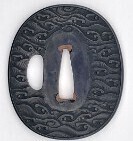After a recent issue, I am presenting this one with my heart in my mouth
I picked this one up from Jauce. It seems to show rice, either after it has been harvested, or just before. Definitely, iron, and highlighted with what looks like gold leaf.
Any thoughts on it when it comes to authenticity, origins, etc?
This one was not expensive and it looks and feels OK, but I remain very wary of buying from Jauce in general.
Thanks in advance…



